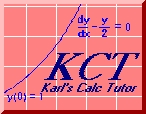

In is easy to apply the
f(x) = ln(1 + x) + ln(1 - x)Each summand is a composite, u(v(x)) and u(w(x)) respectively, where
u(v) = ln(v) or u(w) = ln(w) v(x) = 1 + x w(x) = 1 - xWhen you take the derivatives of each of these, you get
1 1
u'(v) = or u'(w) =
v w
v'(x) = 1
w'(x) = -1
The chain rule tells us to find
1 1
f'(x) = -
1 + x 1 - x
The second part asks for the derivative of
f(x) = ln(1 - x2)Again you'll need to use the
u(v) = ln(v) v(x) = 1 - x2Taking the derivatives you get
1
u'(v) = -
v
v'(x) = -2x
The chain rule tells you to find
-2x
f'(x) =
1 - x2
The problem asks you to show that this derivative is equal to the
the first one you did. At first they seem different. But with a little
algebra you can turn the first expression into the second. Simply put the two
summands that constitute that first expression over a common denominator.
That common denominator would be the product of the two denominators,
1 - x 1 + x -2x
f'(x) = - =
(1 + x)(1 - x) (1 + x)(1 - x) (1 + x)(1 - x)
And since it is easy to show that
email me at hahn@netsrq.com